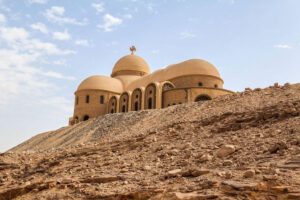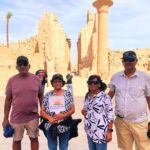St Paul the Anchorite Monastery ,Nestled in the heart of Egypt’s Eastern Desert lies the Monastery of Saint Paul, Known for its remarkable spiritual heritage, breathtaking desert landscape, and enduring architecture, this monastery offers visitors a unique blend of history, faith, and solitude.
The Story Behind St. Paul the Anchorite
Before delving into the monastery itself, it’s essential to understand the man behind it. St. Paul the Anchorite, also known as Paul of Thebes, is considered the first Christian hermit. Born in the 3rd century AD in Thebes (modern-day Luxor), he fled to the desert during the persecution of Christians under Emperor Decius.
At just 16 years old, Paul retreated into the wilderness to live a life devoted to prayer, fasting, and solitude. He is said to have lived in a cave for over 80 years, sustained by a spring of fresh water and dates from a palm tree. According to Christian tradition, a raven brought him half a loaf of bread daily, a miraculous provision from God.

The Founding of the Monastery
The St Paul the Anchorite Monastery was established in the 4th century AD, shortly after St. Paul’s death. Legend has it that St. Anthony the Great, another prominent Christian monk, buried St. Paul and built a chapel on the site of his cave. Over the centuries, this small chapel grew into a full-fledged monastery, attracting monks and pilgrims from around the world.
Today, the monastery remains an active site of worship and monastic life, housing a small community of Coptic Orthodox monks who continue to uphold the spiritual traditions of their predecessors.
What Makes St Paul the Anchorite Monastery Special?
1. Architectural Marvel in the Desert
The monastery’s architecture is a harmonious blend of ancient and modern influences. Built into the rugged cliffs of the desert, it features high stone walls designed to protect the monks from invasions and harsh weather conditions.
The monastery is divided into several sections:
- The Cave of St. Paul: This sacred site is believed to be the very cave where St. Paul lived.
- Ancient Churches: The Monastery houses three main churches, including the Church of St. Paul, which is adorned with stunning frescoes and Coptic icons.
- Monastic Cells and Gardens: The monks’ living quarters and a small garden provide a glimpse into their simple, self-sustaining lifestyle.
2. A Historical Treasure Trove
The monastery is a living museum of Coptic Christianity. Its walls are adorned with ancient manuscripts, relics, and icons that tell the story of early Christian monasticism. Visitors can also see the well where St. Paul reportedly drew water and the palm tree that sustained him.
3. A Place of Pilgrimage and Reflection
For many, a visit to St Paul the Anchorite Monastery is more than just a historical excursion—it’s a spiritual journey. The monastery’s peaceful atmosphere and remote location make it an ideal place for prayer, meditation, and self-reflection.
Visiting St. Paul the Anchorite Monastery
Location and Accessibility
The monastery is situated near the Red Sea Mountains, approximately 155 kilometers southeast of Cairo and 25 kilometers from the Monastery of St. Anthony, another significant monastic site.
Most visitors combine a trip to both monasteries, as they are relatively close and share a connected history. The journey involves a scenic drive through Egypt’s rugged desert terrain, offering stunning views of the surrounding mountains.
Best Time to Visit
The ideal time to visit St Paul the Anchorite Monastery is during Egypt’s cooler months, from October to April. Summers in the desert can be scorching, making the experience less enjoyable.
What to Expect
- Guided Tours: While the monastery is a functioning religious site, guided tours are available to help visitors understand its history and significance.
- Cultural Sensitivity: Modest clothing is recommended out of respect for the monastic community.
- Photography: Visitors are allowed to take photos, but it’s best to confirm with your guide or hosts beforehand.
A Journey Worth Taking
St Paul the Anchorite Monastery is more than just a historical site—it’s a testament to the enduring power of faith, solitude, and simplicity. Whether you’re drawn by its spiritual significance, historical value, or natural beauty, a visit to this monastery is a journey into the heart of Egypt’s religious and cultural heritage.
So, the next time you find yourself in Egypt, venture beyond the pyramids and the Nile. Discover the hidden gem of the Eastern Desert and let the legacy of St. Paul the Anchorite inspire you.




